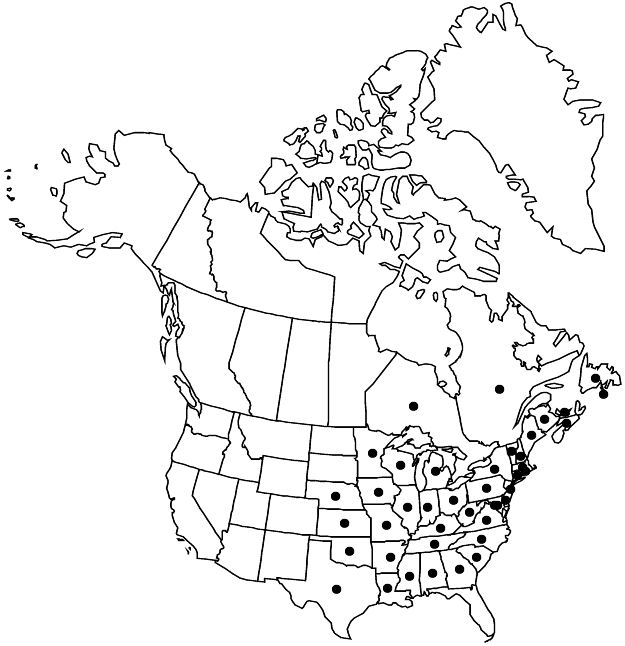Potentilla simplex
Fl. Bor.-Amer. 1: 303. 1803.
Rootstocks horizontal, irregularly thickened or moniliform, 1–8 cm. Stems initially erect to ascending to 5 dm, then arching above ground-level, becoming prostrate, flagelliform, not branched, rooting at distal nodes, (0.5–)1.5–12 dm. Basal leaves persistent or ephemeral, usually palmate, 3.5–20 cm; petiole 1–15 cm, long hairs ± abundant, appressed to spreading, (0.5–)1–3 mm, weak to ± stiff, glands absent or sparse, sometimes common; leaflets 5(–7), central narrowly elliptic to obovate, 1.5–5 × 0.5–2.5 cm, distal 1/2–3/4 of margin incised 1/4–1/3 to midvein, teeth 4–8(–13) per side, surfaces similar to ± dissimilar, abaxial green to silvery white, sparsely to abundantly hairy, adaxial green, glabrate or sparsely to moderately hairy. Cauline leaves (0–)1 proximal to 1st flowering node, well expanded at anthesis, usually palmate, 2.5–6(–9) cm; petiole 0–2(–4) cm; leaflets (3–)5, often more elongate than those of basal leaves, ± elliptic to oblanceolate, sometimes obovate, 1.5–6(–7.5) × 0.5–2(–3) cm, apex acute to obtuse. Inflorescences solitary flowers at stolon nodes. Pedicels 1–5(–8.5) cm. Flowers 5(–6)-merous; epicalyx bractlets linear to narrowly lanceolate, 2–5 × 1–1.5(–2) mm, often larger than sepals (especially in bud); hypanthium 3–5 mm diam.; sepals 4–6 mm, apex broadly acute; petals 4–7 × 3–6 mm, apex rounded to ± retuse; stamens ca. 20, filaments 0.5–2 mm, anthers 0.6–1 mm; carpels 20–50, styles 0.8–1.5 mm. Achenes 0.9–1.2 mm, faintly rugose.
Phenology: Flowering (Mar–)Apr–Jul(–Aug).
Habitat: Dry or infrequently moist flats and slopes in pastures, dry meadows, roadsides, old fields, edges of mixed oak and conifer woodlands, often on acidic soil
Elevation: 0–800 m
Distribution

St. Pierre and Miquelon, N.B., Nfld. and Labr. (Nfld.), N.S., Ont., P.E.I., Que., Ala., Ark., Conn., Del., D.C., Ga., Ill., Ind., Iowa, Kans., Ky., La., Maine, Md., Mass., Mich., Minn., Miss., Mo., Nebr., N.H., N.J., N.Y., N.C., Ohio, Okla., Pa., R.I., S.C., Tenn., Tex., Vt., Va., W.Va., Wis.
Discussion
The distinction between Potentilla simplex and P. canadensis is subtle, and the former is often misidentified as the latter; additional features to distinguish the two species are provided by M. L. Fernald (1931).
Selected References
None.